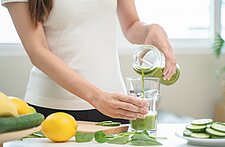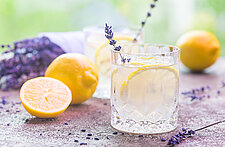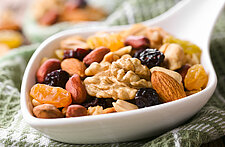 By Kate Schlientz, IntoxiKate.com
By Kate Schlientz, IntoxiKate.com
Chefs, restaurateurs, and mixologists have boots to the ground, and with a close eye on the consumer pulse, can quickly introduce and navigate new flavors that quickly transform into trends. Product developers are following suit, and the true innovation is all about flavor. Here are a few of the top craft-to-bottle trends:
CLICK HERE to read my first article: Craft Makes it's Way to the Snack Category
Veggie Beverages
As the vegetable made its way back to the center of the plate, consumers quickly took note. Vegetable-based beverages are on the rise, but bitter may be the better way to go, as fermented varieties seem to be the biggest sale drivers. Chefs explored palates, offering a wide-variety of fermented foods, paving the way to consumer’s openness to less traditional beverage flavors. Twists on kombucha, kefir, and kefir waters have all made their way to store shelves.
 We also first saw bone broth listed on posh restaurant menus. But Bonafide Provisions pioneered the production of frozen organic bone broth for store shelves, and their next product likely proves to be a beverage game changer. Their ready-to-drink USDA Organic Drinkable Veggies™ line blends nutrient-rich vegetables with bone broth. “Thrive,” for example, combines butternut squash, yellow onion, fennel, turmeric (a trending ingredient), and Celtic sea salt with chicken broth.
We also first saw bone broth listed on posh restaurant menus. But Bonafide Provisions pioneered the production of frozen organic bone broth for store shelves, and their next product likely proves to be a beverage game changer. Their ready-to-drink USDA Organic Drinkable Veggies™ line blends nutrient-rich vegetables with bone broth. “Thrive,” for example, combines butternut squash, yellow onion, fennel, turmeric (a trending ingredient), and Celtic sea salt with chicken broth.
Kayco introduced a line of organic, cold-pressed juices this spring with one vegetable serving as the root of the concept. Beetology features an interesting lineup of flavor combos—Beet, Lemon and Ginger; Beet and Veggie; Beet and Tropical Fruit; Beet and Berry; and Beet and Cherry.
CLICK HERE to learn how to position your brand in the Craft/Artisan Space
Convenient and Health-Conscious
Consumers are also searching for ways to incorporate this year’s hot health trends into the pantry. Cold-pressed juices and probiotics—all thought as extensions of the restaurant farm to table movement and fermenting fervor—are emerging, offering consumers time-saving ways to achieve their nutrition goals without sacrificing flavor.
Starbucks recently added a serious cold-buster, known as the “Medicine Ball,” to their official beverage program. The drink—a Venti cup with a bag of Jade Citrus Mint Tea and a bag of Peach Tranquility Tea is filled half with hot water and half steamed lemonade and finished with a little honey and optional pump of peppermint—took off when it was created by a customer and shared on Instagram.
 SuperLeaf LLC’s detoxwater offers consumers a ready-to-drink aloe-infused beverage—with vitamins and electrolytes to boot—masking the something-to-be-desired taste of aloe vera with flavors like Original Lychee and White Grape, Piñamint (Pineapple and Mint) and Mangaloe Mango. Harmless Harvest also showcased interesting flavors in a recent Winter Fancy Food Show. Their new line of beverages, Harmless Coconut Probiotics, combine a “refreshing beverage” with probiotics to support digestive and immune health. But with varieties like Strawberry, Blueberry and Açai, Mango, and Acerolas, they pair probiotics with great super fruit flavor. Caliwater Cactus Water also launched a new flavor this year—Cactus and Lime with Fresh Ginger—modeling the flavor profile of the Moscow Mule.
SuperLeaf LLC’s detoxwater offers consumers a ready-to-drink aloe-infused beverage—with vitamins and electrolytes to boot—masking the something-to-be-desired taste of aloe vera with flavors like Original Lychee and White Grape, Piñamint (Pineapple and Mint) and Mangaloe Mango. Harmless Harvest also showcased interesting flavors in a recent Winter Fancy Food Show. Their new line of beverages, Harmless Coconut Probiotics, combine a “refreshing beverage” with probiotics to support digestive and immune health. But with varieties like Strawberry, Blueberry and Açai, Mango, and Acerolas, they pair probiotics with great super fruit flavor. Caliwater Cactus Water also launched a new flavor this year—Cactus and Lime with Fresh Ginger—modeling the flavor profile of the Moscow Mule.
CLICK HERE to get more craft/artisan trends in the weekly in-sight newsletter
Borrowed from the Bar
Caliwater isn’t the only beverage channeling mixologists and inspiring unique flavor profiles. The craft revolution pushes on with one of the most apparent cocktail copy cats, Grown Up Soda (GuS). The Mixer line was created to enjoy with or without the recommended spirit, and offers Mojito, Moscow Mule, Sparkling Cosmo, and Tonic and Lime varieties.
The coffee segment is also borrowing from the bar, with Jack Daniel’s teaming up with World of Coffee Inc, to offer a cup of 100% Arabic coffee medium roasted and infused with Jack Daniel’s Old No. 7 Tennessee Whiskey. If that wasn’t enough to get the heart pumping, Napa Valley winemaker Molinari Private Reserve and Wild Card Roasters put their heads together to create a wine-infused coffee bean.
Stay tuned to in-sight for more articles from Kate Schlientz of IntoxiKate.com!





